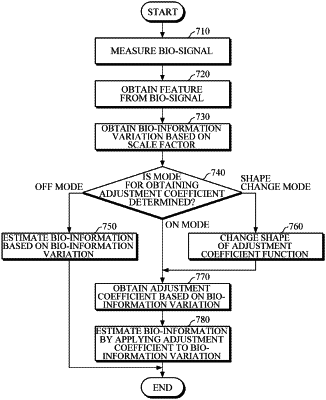| CPC A61B 5/0059 (2013.01) [A61B 5/02156 (2013.01); A61B 5/7225 (2013.01); A61B 5/7275 (2013.01); A61B 5/02007 (2013.01); A61B 5/681 (2013.01); A61B 2560/0223 (2013.01)] | 18 Claims |

|
1. An apparatus for estimating bio-information, the apparatus comprising:
a bio-signal sensor configured to measure a bio-signal from an object at an estimation time to monitor a health state of the object;
at least one of a strap, a fingerprint sensor, or a touch panel;
a memory configured to store an adjustment coefficient function;
an image sensor configured to capture an image of the object; and
a processor configured to:
obtain a feature based on the measured bio-signal at the estimation time;
obtain a bio-information variation based on a variation of the obtained feature in comparison to a feature that is obtained based on a bio-signal measured at a reference time;
adaptively change an adjustment coefficient based on the bio-information variation while the bio-signal sensor is monitoring the health state of the object, using the adjustment coefficient function stored in the memory so that as an absolute value of the bio-information variation decreases, the adjustment coefficient increases, and as the absolute value of the bio-information variation increases, the adjustment coefficient decreases or has a constant value after a predetermined point of the absolute value of the bio-information variation;
estimate the bio-information with improved accuracy to prevent danger to a user's health, the user including the object, by applying the adjustment coefficient to the bio-information variation;
determine whether the estimated bio-information falls outside a predetermined normal range;
when the estimated bio-information has been determined to fall outside the predetermined normal range, control an alarm to be activated;
based on the captured image received from the image sensor, detect a relative position of the object with respect to an actual position of the bio-signal sensor; and
based on the detected relative position of the object, direct a display to display the relative position of the object to the user to guide estimation of the bio-information with improved accuracy;
wherein the bio-signal sensor comprises:
a light source configured to emit light onto the object; and
a detector configured to detect light that is scattered from the object.
|